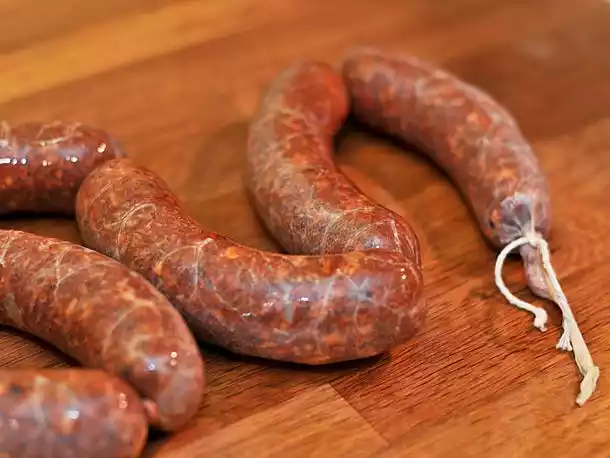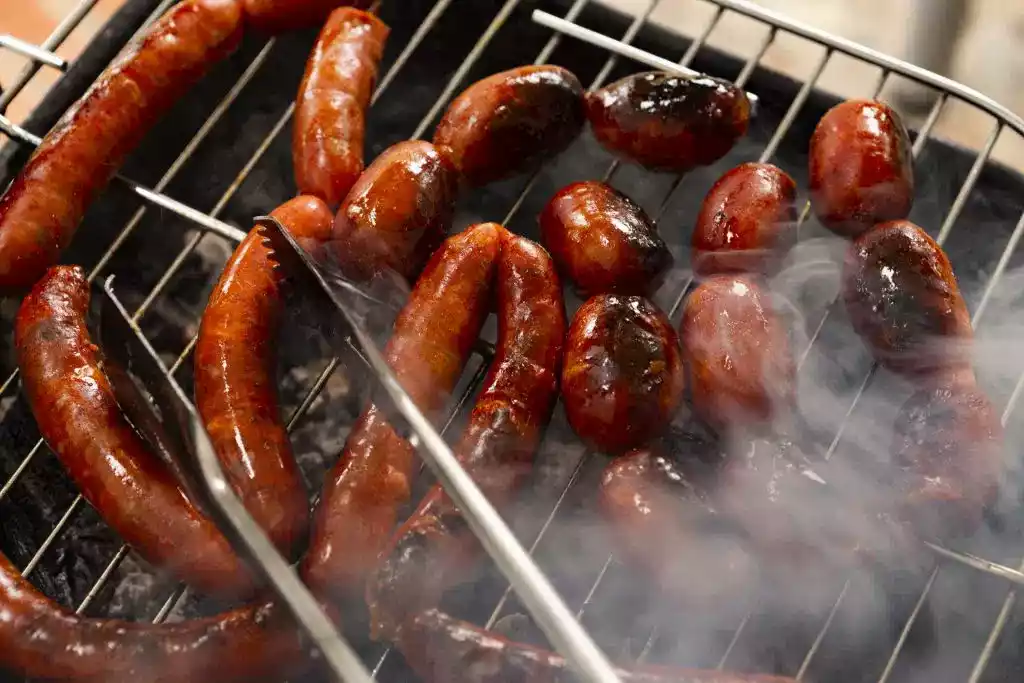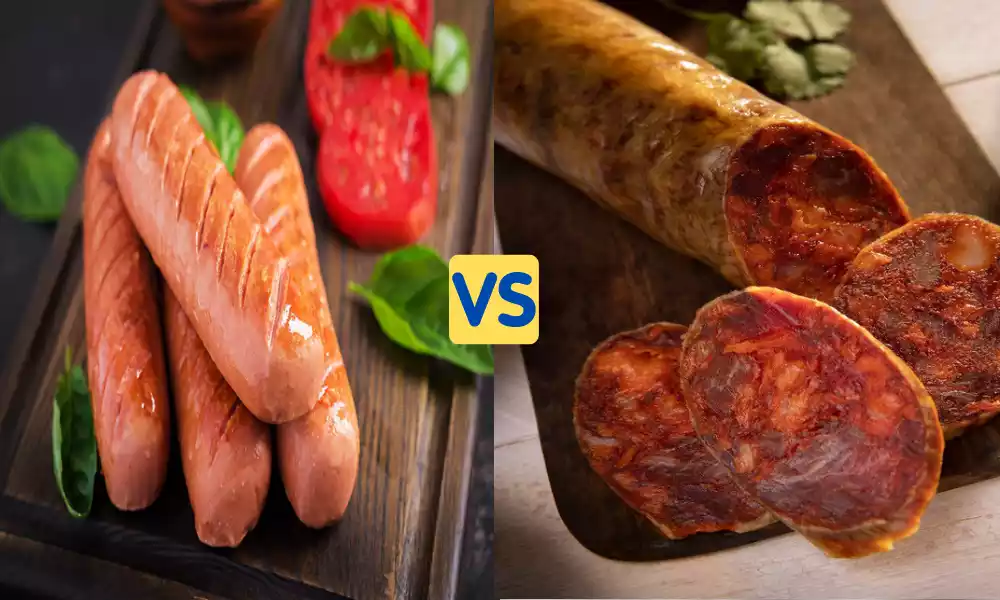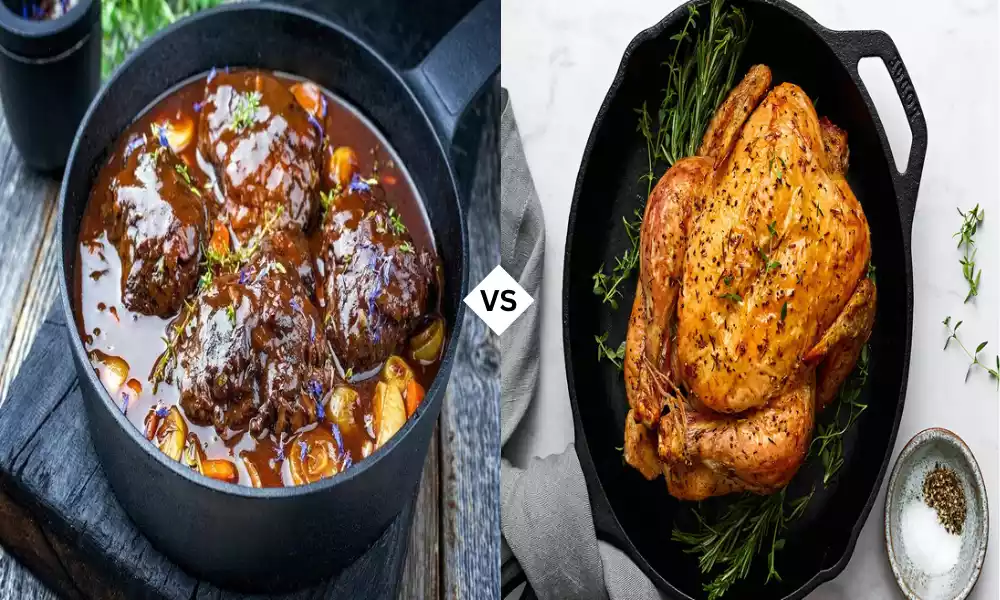Chorizo and Longaniza are two savory sausages with distinct flavors, that have left an indelible mark on global cuisine. Originating from different culinary traditions, these sausages have found their way into a plethora of dishes across various cultures. We delve into the world of Chorizo and Longaniza, exploring their origins, flavors, and cultural significance. Join us as we embark on a flavorful journey that celebrates the art of sausages.
What is Chorizo?

Chorizo is a highly flavorful sausage originating from the Iberian Peninsula, with Spain and Portugal being its primary culinary homes. Crafted from ground pork, although sometimes incorporating beef or mixed meats, chorizo is renowned for its deep reddish hue and robust taste. This distinct color and flavor stem from the inclusion of paprika, which contributes a smoky essence, along with a blend of garlic, cayenne pepper, and assorted spices.
This sausage undergoes a curing and often fermenting process, resulting in both fresh and dried versions that offer varying intensities of taste. With Spanish chorizo divided into spicy (“chorizo picante”) and sweet (“chorizo dulce”) varieties, chorizo boasts a wide spectrum of regional adaptations.
Chorizo’s versatility in cooking applications is another key aspect of its allure. It can be pan-fried, grilled, or sautéed, releasing flavorful oils that enhance the overall dish. Moreover, chorizo is a common ingredient in diverse culinary creations like stews, soups, paella, sandwiches, and tapas, adding a rich, savory complexity to each preparation.
Beyond its original homeland, chorizo has found a global presence, integrating seamlessly into a multitude of cuisines due to its strong and distinctive taste. Whether enjoyed as a standalone delight or blended into complex dishes, chorizo’s impactful flavor profile remains a culinary favorite worldwide.
Types of Chorizo
There are several types of chorizo, each with its own unique characteristics, flavors, and culinary uses. Here are some of the most notable types of chorizo:
- Spanish Chorizo:
- Chorizo Picante: Also known as spicy chorizo, this variety is seasoned with hot paprika and other spices, giving it a fiery and bold flavor. It’s often used to add a kick to dishes and is a popular choice in Spanish tapas.
- Chorizo Dulce: Also referred to as sweet chorizo, this version is seasoned with mild paprika and tends to have a milder heat level. It’s characterized by its slightly sweet and smoky taste.
- Mexican Chorizo:
- Fresh Chorizo: Mexican chorizo is often made with ground pork combined with various spices, including chili powder, garlic, and vinegar. It’s typically sold uncured and requires cooking before consumption. The vibrant red color comes from the use of chili powder.
- Cured Chorizo: Similar to Spanish chorizo, Mexican cured chorizo is dried and aged, resulting in a more concentrated flavor. It’s often used as a topping for dishes or as a flavoring agent in Mexican cuisine.
- Portuguese Chorizo:
- Chouriço: Portuguese chorizo, known as chouriço, is similar to Spanish chorizo but often includes a mix of pork and other meats. It’s seasoned with garlic and paprika, and the mixture is stuffed into casings for curing.
- Argentinian and Uruguayan Chorizo:
- Chorizo Criollo: Popular in South American countries like Argentina and Uruguay, this chorizo is seasoned with garlic, paprika, and other spices. It’s often served grilled and is a staple in traditional barbecues known as “asados.”
- Filipino Chorizo:
- Chorizo de Cebu: A sweet and tangy version of chorizo found in the Philippines, particularly in the Cebu region. It’s often made with a mixture of pork, sugar, vinegar, and spices.
- Colombian Chorizo:
- Chorizo Colombiano: Colombian chorizo is made with a mixture of pork, spices, and herbs. It’s often served grilled or fried and is a common street food in Colombia.
- Basque Chorizo:
- Chorizo Vasco: Hailing from the Basque region of Spain, this chorizo is known for its use of high-quality pork and a blend of mild and spicy peppers. It’s often enjoyed sliced and served with crusty bread.
These are just a few examples of the many types of chorizo found around the world. Each variety reflects the culinary traditions and preferences of the region in which it’s enjoyed, offering a wide range of flavors and experiences for enthusiasts of this flavorful sausage.
Chorizo Ingredients and Flavor Profile
- Chorizo Ingredients
The specific ingredients used in chorizo can vary depending on the type and regional variations. There are some common ingredients that are often found in chorizo recipes:
- Meat: Chorizo is typically made from pork, although other meats like beef, chicken, or a combination of meats can also be used.
- Seasonings: Chorizo is known for its rich and complex flavor profile, achieved through a combination of various seasonings. Common seasonings include paprika (which provides the characteristic color and smokiness), garlic, cayenne pepper, ground chili, black pepper, and sometimes cumin.
- Salt: Salt is essential for curing the meat and enhancing the overall flavor.
- Vinegar: Vinegar is often used to add acidity, which balances the richness of the meat and spices. It also aids in preserving the sausage.
- Fat: Chorizo has a relatively high fat content, which contributes to its succulent texture and rich taste. Fatback or other fatty cuts of meat are commonly used.
- Curing Agents: In cured varieties of chorizo, curing agents like nitrates or nitrites are often used to preserve the sausage and enhance its color.
- Flavor Profile
Chorizo’s flavor profile is a harmonious blend of smokiness, spiciness, and a medley of spices. The exact flavor can vary depending on the type of chorizo and the regional influences. Here’s a general description of the flavor profile:
- Smokiness: The addition of paprika, often smoked paprika, gives chorizo its characteristic smoky flavor. This smokiness can range from mild to intense, depending on the type of paprika used.
- Spiciness: Chorizo can range from mildly spicy to quite hot, depending on the type of chili peppers and spices used. Spiciness contributes to the sausage’s overall complexity and adds a zesty kick.
- Garlic: Garlic is a prominent flavor in chorizo, contributing its distinct aroma and enhancing the overall taste.
- Sweetness: Some varieties of chorizo, such as sweet or mild versions, may have a subtle underlying sweetness that balances the spiciness and smokiness.
- Umami: The combination of spices, paprika, and the curing process can result in a deep umami flavor that’s rich and satisfying.
- Savory: Chorizo’s rich fat content contributes to its savory, meaty taste that lingers on the palate.
The balance and intensity of these flavors can vary from region to region, and even from one producer to another. This diversity is part of what makes chorizo such a versatile and beloved ingredient in various cuisines around the world.
What is Longaniza?

Longaniza is a type of sausage that originates from Spain and has become a culinary sensation across various cultures. This flavorful sausage is crafted from ground pork or a mixture of meats, combined with an array of spices and seasonings that contribute to its distinctive taste.
Its flavor profile is a harmonious blend of spices such as paprika, garlic, cayenne pepper, and regional herbs, resulting in a medley of smokiness, spiciness, and savory richness. Longaniza’s journey through history has led to diverse regional adaptations, each with its own unique characteristics, making it a versatile ingredient found in cuisines around the world.
While its roots lie in Spain, longaniza has taken on new identities in different countries. Mexican longaniza is known for its vibrant chili pepper flavors, Filipino longanisa offers a delightful combination of sweet and savory, and Dominican and Puerto Rican variations showcase unique herb and spice blends.
Longaniza can be cooked in various ways, from grilling to pan-frying, and it often finds its way into dishes like rice, beans, tortillas, and sandwiches. Its global presence and adaptability reflect the evolving nature of culinary traditions, making longaniza a symbol of culinary diversity and innovation.
Longaniza Varieties
Longaniza, a versatile sausage originating from Spain, has evolved into diverse regional varieties around the world:
- Spanish Longaniza: Paprika-spiced pork sausage, air-dried or smoked.
- Mexican Longaniza: Bold with chili peppers, enjoyed grilled or in tacos.
- Filipino Longanisa: Sweet and savory pork sausage, various regional styles.
- Dominican Longaniza: Aromatic with oregano, garlic, and vinegar.
- Puerto Rican Longaniza: Flavored with spices, including annatto.
- Chilean Longaniza: Seasoned with cumin, garlic, and oregano.
- Argentine Longaniza: Grilled asado sausage with spices and herbs.
- Nicaraguan Longaniza: Achiote-spiced, enjoyed with rice and tortillas.
Each type boasts its unique blend of spices, reflecting the culinary diversity and cultural richness of its origin.
Longaniza Ingredients and Flavor Profile
- Ingredients
Longaniza’s ingredients can vary based on its regional adaptations, but certain components are commonly found in its composition:
- Meat: Typically made from ground pork, although beef, chicken, or mixed meats are also used in some variations.
- Spices: A blend of spices gives longaniza its distinct flavor. These may include paprika, cayenne pepper, garlic, cumin, oregano, and regional herbs.
- Sugar: In some varieties, sugar or sweeteners are added to balance the savory and spicy flavors. This is especially common in sweeter styles like Filipino longanisa.
- Salt: Essential for flavor enhancement and preservation during curing.
- Vinegar or Citrus: For acidity, enhancing flavors, and aiding in the curing process.
- Casing: Natural or synthetic casings are used to encase the mixture and give the sausage its traditional shape.
- Flavor Profile
Longaniza’s flavor profile is a symphony of savory, smoky, and often spicy notes, punctuated by the following key characteristics:
- Spiciness: The use of spices like paprika, cayenne pepper, and chili imparts a delightful level of spiciness. The intensity can vary, from mildly seasoned to boldly hot, depending on the variety.
- Smokiness: Some longaniza types are smoked or air-dried, lending a smoky undertone to the overall flavor.
- Savory: The combination of meats, spices, and curing results in a rich, umami-laden taste.
- Herbal Aromatics: Oregano, garlic, and regional herbs contribute aromatic layers, enriching the overall profile.
- Sweetness: Certain longaniza styles, like Filipino, may have a gentle sweetness from added sugar or sweeteners.
- Balanced Complexity: The interplay of spices, herbs, and meat creates a balanced and multifaceted taste experience.
Longaniza’s flavor profile is a celebration of the cultural and culinary diversity it embodies, making it a cherished ingredient across various cuisines.
Comparison table of Chorizo and Longaniza
Here’s a comparison table highlighting the key differences between Chorizo and Longaniza:
| Aspect | Chorizo | Longaniza |
|---|---|---|
| Origin | Spain | Spain (origin), Adapted globally |
| Meat | Primarily pork, can include beef, or mixed meats | Primarily pork, can include other meats |
| Seasonings | Paprika, garlic, cayenne pepper, spices | Paprika, garlic, cumin, regional herbs, spices |
| Flavor Profile | Bold, smoky, spicy, rich | Spicy to mild, smoky, savory, aromatic |
| Varieties | Spanish (spicy, sweet), Mexican, Portuguese, etc. | Mexican, Filipino, Dominican, Puerto Rican, etc. |
| Culinary Uses | Grilled, fried, stews, tapas, soups | Grilled, pan-fried, stews, tacos, rice dishes |
| Global Spread | Widely recognized, various international cuisines | Adapts to local flavors, embraced worldwide |
| Cultural Impact | Spanish tradition, global culinary icon | Embraced by different cultures, regional pride |
| Curing | Can be cured or fresh | Often air-dried, smoked, or cured |
| Spiciness | Can range from mild to very spicy | Spiciness varies by type and region |
| Ingredients | Paprika, garlic, various spices, fat | Paprika, garlic, regional herbs, sugar (sometimes) |
| Cultural Ties | Celebrated in Spanish cuisine, global recognition | Cultural significance varies by region |
Both chorizo and longaniza have various regional adaptations, and the information provided in the table is a general overview. The flavor and characteristics can vary depending on the specific type and region.
Culinary Uses

Both Chorizo and Longaniza are versatile sausages that can elevate a wide range of dishes. Here’s a look at their culinary uses and how they can be enjoyed in various preparations:
Chorizo Culinary Uses:
- Tapas and Charcuterie: Chorizo is a classic choice for Spanish tapas. Sliced chorizo can be served on a charcuterie board alongside cheeses, olives, and crusty bread.
- Paella: Chorizo adds depth and flavor to the famous Spanish dish, paella. Its spices infuse the rice and other ingredients with a rich taste.
- Stews and Soups: Chorizo is a great addition to hearty stews and soups. Its spices and smoky flavors enhance the overall depth of the dish.
- Sandwiches: Sliced chorizo can be used to create flavorful sandwiches and subs. It pairs well with various condiments and vegetables.
- Pasta Dishes: Incorporate crumbled or sliced chorizo into pasta dishes for a burst of flavor. These sauces pair wonderfully with tomato-based or creamy-based sauces.
- Grilled and Skewered: Chorizo can be grilled on its own or threaded onto skewers with vegetables for a delicious and simple grilled meal.
Longaniza Culinary Uses:
- Grilled Delight: Longaniza shines on the grill, where its smoky flavor and spices are showcased. Grilled longaniza can be enjoyed on its own or in sandwiches.
- Breakfast Favorites: Longaniza can be a star ingredient in breakfast burritos, omelets, and hash. Its savory taste adds a flavorful kick to the morning.
- Rice and Rice Dishes: Add sliced longaniza to rice dishes for an extra layer of flavor. Longaniza fried rice or rice bowls are popular choices.
- Tacos and Wraps: Longaniza can be the perfect filling for tacos, wraps, and burritos. Pair it with fresh vegetables and sauces for a balanced bite.
- Stir-Fries: Sliced longaniza is a fantastic addition to stir-fry dishes, contributing its unique blend of spices to the overall flavor.
- Soups and Stews: Just like chorizo, longaniza can be added to soups and stews to infuse them with its aromatic essence.
Both chorizo and longaniza lend their distinct flavors and spices to a variety of culinary creations. Their adaptability makes them ideal for experimentation, allowing you to craft unique dishes that reflect your preferences and creativity.
Pairing and Serving
Pairing and serving chorizo and longaniza can enhance their flavors and create delicious and well-balanced meals. Here are some pairing and serving ideas for both sausages:
Chorizo Pairing and Serving:
- Cheese Platter: Create a charcuterie board with sliced chorizo, an assortment of cheeses, olives, crackers, and fruits.
- Spanish Tapas: Serve sliced chorizo as part of a tapas spread with items like marinated artichokes, stuffed peppers, and garlic shrimp.
- Paella: Incorporate chorizo into a traditional Spanish paella, combining it with saffron-infused rice, seafood, and vegetables.
- Stuffed Peppers: Use chorizo as a flavorful filling for stuffed bell peppers, along with rice, tomatoes, and spices.
- Chorizo and Egg Breakfast: Add diced chorizo to scrambled eggs for a savory breakfast scramble.
- Soup Enhancer: Enhance soups like lentil or potato with slices of chorizo for added depth of flavor.
Longaniza Pairing and Serving:
- Grilled Vegetable Platter: Serve grilled longaniza with a variety of grilled vegetables, such as bell peppers, zucchini, and onions.
- Breakfast Burrito: Wrap scrambled eggs, sautéed vegetables, and longaniza in a tortilla for a hearty breakfast burrito.
- Rice Bowls: Place sliced longaniza over a bowl of rice, and add sautéed vegetables, beans, and a drizzle of sauce.
- Stir-Fry: Create a vibrant stir-fry by tossing sliced longaniza with colorful vegetables and a flavorful sauce.
- Longaniza Tacos: Make tacos with longaniza, shredded lettuce, diced tomatoes, and your choice of toppings.
- Grilled Sandwich: Use grilled longaniza as a filling for sandwiches along with cheese, greens, and condiments.
Remember to balance the richness of the sausages with fresh and crisp elements, such as salads or pickled vegetables. Additionally, consider the regional flavors and ingredients when pairing with other dishes to create a harmonious and delightful meal experience.
The Art of Making Chorizo and Longaniza
Crafting homemade chorizo and longaniza is a rewarding culinary endeavor that allows you to control the ingredients, flavors, and techniques used in these sausages. While the specific recipes and methods can vary based on regional traditions and personal preferences, here’s an overview of the art of making chorizo and longaniza:
Ingredients and Preparation:
- Meat Selection: Choose quality cuts of meat, such as pork, beef, or a mixture of both. Fat is essential for flavor and texture, so include a reasonable amount.
- Seasoning: Prepare a mixture of spices and herbs that reflect the desired flavor profile. Common ingredients include paprika, garlic, cayenne pepper, cumin, oregano, and more.
- Curing Agents: Some recipes use curing agents like nitrates or nitrites to preserve the sausages and enhance their color.
- Binding: To ensure proper texture, you may need to add breadcrumbs, rice, or other binding agents.
Steps to Make:
- Grinding: Grind the meat through a coarse grinder. The size of the grind depends on personal preference.
- Seasoning: Mix the ground meat with the prepared spice mixture. Make sure the seasonings are evenly distributed throughout the mixture.
- Casing: Stuff the seasoned meat mixture into natural or synthetic casings. Twist and tie them to create individual sausages.
- Curing (if applicable): If you’re making cured sausages, let them rest in a cool, dry place for the curing process to take place. This step is optional and dependent upon your recipe.
- Drying and Aging (if applicable): For certain varieties, allow the sausages to dry and age, enhancing their flavors and texture over time.
- Cooking: Cook the sausages using your preferred method—grilling, pan-frying, baking, or simmering in stews.
Tips and Considerations:
- Sanitation: Ensure all equipment and surfaces are clean and sanitized to prevent contamination.
- Experimentation: Don’t be afraid to experiment with flavors and ingredients to create your signature chorizo or longaniza.
- Taste Testing: Before stuffing the casings, cook a small portion of the mixture to taste and adjust seasonings if needed.
- Temperature Control: Properly control cooking temperatures to ensure the sausages are cooked through while maintaining their juiciness.
- Storage: Store cooked sausages in the refrigerator and consume within a reasonable time to maintain freshness.
Making chorizo and longaniza is a blend of culinary artistry and tradition. As you embark on this journey, you’ll not only create delicious sausages but also gain a deeper appreciation for the flavors and techniques that define these treasured dishes.
Summary
Chorizo and Longaniza stand as vibrant threads woven into the tapestry of global cuisine. With Chorizo’s bold, smoky essence and Longaniza’s sweet-savory allure, these sausages bring an unmatched depth of taste to countless dishes. From traditional recipes that honor cultural heritage to innovative fusion creations that bridge culinary boundaries, Chorizo and Longaniza have become cherished ambassadors of flavor.
As we indulge in the sizzle, aroma, and taste of these sausages, we not only experience their deliciousness but also embrace the rich diversity that makes the world of food so captivating.































